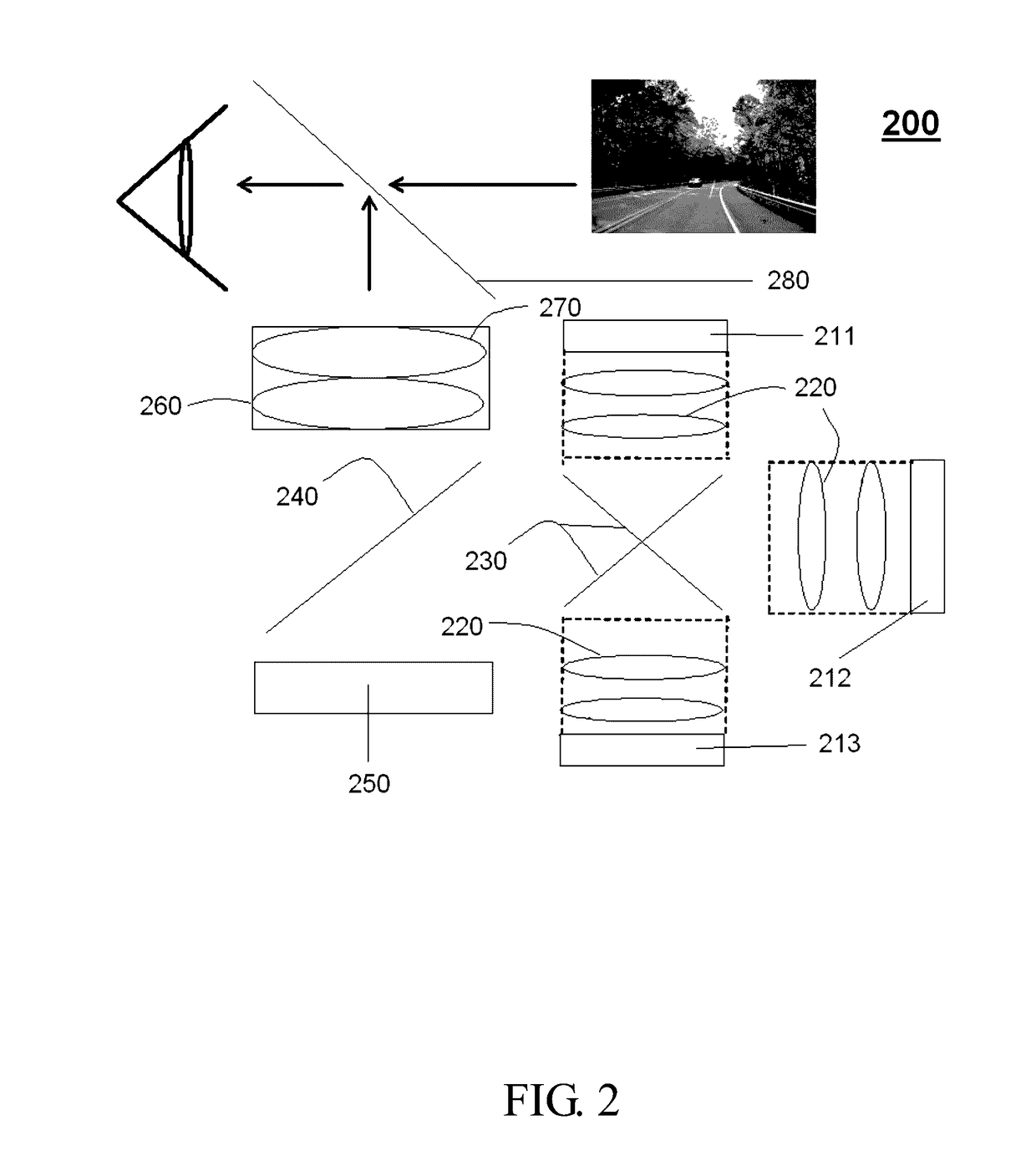See-Through Near-to-Eye Viewing Optical System
an optical system and near-to-eye technology, applied in the direction of stereophonic arrangments, instruments, earpiece/earphone attachments, etc., can solve the problems of short service life, poor color saturation and poor picture quality of lcd displays, and so complex manufacturing processes
- Summary
- Abstract
- Description
- Claims
- Application Information
AI Technical Summary
Benefits of technology
Problems solved by technology
Method used
Image
Examples
first embodiment
[0018]FIG. 1 is a schematic view of the present invention, which illustrates a front appearance of a see-through near-to-eye viewing optical system 100 of the color filter type. In the embodiment shown therein, the see-through near-to-eye viewing optical system 100 comprises an LCOS panel 110, a PBS 120, a post-polarizer 130, an eyepiece 140, a pre-polarizer 150, a white LED illumination system 160 and a beam splitter 170. The LCOS panel 110 comprises a color filter (not shown). When a light is generated by the white LED illumination system 160, the light is concentrated by the pre-polarizer 150 to the PBS 120 and is then reflected by the PBS 120 to the color filter of the LCOS panel 110 where the white light is split into a red light, a green light and a blue light. Then the LCOS panel 110 receives an image from the drive system board (not shown) and projects the image to the post-polarizer 130 and the eyepiece 140 so that the image is magnified by the eyepiece 140 and outputted vi...
second embodiment
[0019]The present invention further provides a see-through near-to-eye viewing optical system 200 of the color sequential type in a second embodiment, a schematic view of which is shown in FIG. 2. The optical system 200 comprises an LCOS panel 250, a PBS 240, a plurality of pre-polarizers 220, a post-polarizer 260, a diachronic mirror 230, an eyepiece 270, a blue LED illumination system 211, a green LED illumination system 212 and a red LED illumination system 213. The blue LED illumination system 211, the green LED illumination system 212 and the red LED illumination system 213 each output a light to a respective pre-polarizer 220. The light is concentrated by the respective pre-polarizer 220 to the dichroic mirror 230 and reflected by the dichroic mirror 230 to the PBS 240, and is then reflected by the PBS 240 to the LCOS panel 250. The LCOS panel 250 receives the image from the drive system board (not shown) and projects the image to the post-polarizer 260 and the eyepiece 270 so...
third embodiment
[0021]In the present invention, a see-through near-to-eye viewing optical system 310 is used, together with image sensors 320 and a drive system board 360, in a see-through head-mounted augmented reality display system 200. FIG. 3A is a front view of this embodiment, and FIG. 3B is a rear view of this embodiment. In this embodiment, an external image is captured by two image sensors 320 and transmitted to the drive system board 360, and then the drive system board 360 processes the external image into a single or a multiple image for output to two optical systems 310. The numbers of the image sensors 320, the drive system board 360 and the optical system 310 are not limited to what described above. Further, the single image includes the external image, an internal image downloaded or stored by the drive system board 360, and an integrated image obtained by integrating the external image and the internal image. The multiple image includes Picture by Picture (PBP) images displayed res...
PUM
| Property | Measurement | Unit |
|---|---|---|
| Angle | aaaaa | aaaaa |
| Volume | aaaaa | aaaaa |
| Frequency | aaaaa | aaaaa |
Abstract
Description
Claims
Application Information
 Login to View More
Login to View More - R&D
- Intellectual Property
- Life Sciences
- Materials
- Tech Scout
- Unparalleled Data Quality
- Higher Quality Content
- 60% Fewer Hallucinations
Browse by: Latest US Patents, China's latest patents, Technical Efficacy Thesaurus, Application Domain, Technology Topic, Popular Technical Reports.
© 2025 PatSnap. All rights reserved.Legal|Privacy policy|Modern Slavery Act Transparency Statement|Sitemap|About US| Contact US: help@patsnap.com



